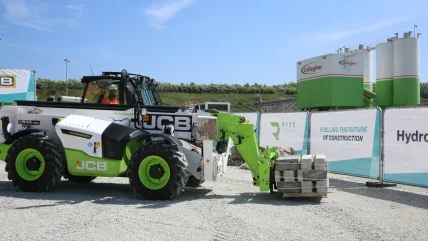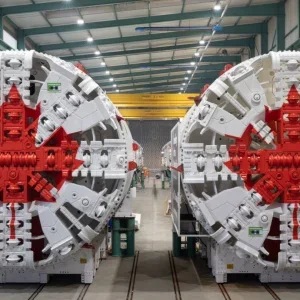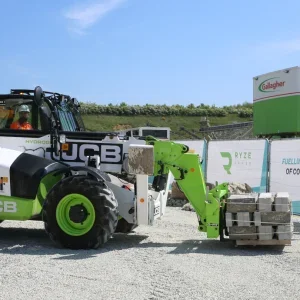
The Lower Thames Crossing project’s plan to replace diesel with hydrogen in its heavy construction machinery has moved a step closer following completion of its first hydrogen trial in partnership with Gallagher Group, JCB and hydrogen supplier Ryze Power.
The trial, hosted at Gallagher’s Hermitage Quarry in Kent, was carried out using a JCB 540-180H Loadall powered by a hydrogen combustion engine fuelled with low carbon hydrogen. The machine replaced the use of an existing diesel-powered JCB Loadall for masonry work and demonstrated the safe operation of hydrogen combustion powered equipment and mobile refuelling infrastructure.
National Highways says the trial proved the equipment would not only meet the project’s needs but would produce zero tailpipe emissions and save around 205kg of CO₂ per machine, per week when compared to traditional diesel fuelled equivalents.
The Lower Thames Crossing is a Pathfinder project exploring low-carbon construction. It has a target of a 70% reduction in its construction carbon, against its original calculations, and a significant proportion of the reductions will be achieved by eliminating diesel from its construction sites by 2027. During construction, electric vehicles and plant, and hydrogen to power heavy construction machinery will be used.
The contract for the supply, storage and distribution of hydrogen to its construction sites is expected to be awarded later this year.
By buying the largest ever volume of hydrogen on a UK transport project, National Highways says the Lower Thames Crossing will accelerate the construction industry’s shift away from diesel by providing its supply chain the confidence to invest in hydrogen-powered machines, as well as develop the new skills required to operate and maintain them.
It will also help jumpstart development of a hydrogen ‘ecosystem’ in the Thames Estuary, which the Thames Estuary Growth Board estimates to be worth £3.8bn gross value added and would create 9,000 highly skilled jobs by 2035.
National Highways says JCB’s hydrogen engines have undergone rigorous testing – more than 22,500 hours in engine test cells, while JCB hydrogen-powered machines have completed over 30,000 hours of testing on the company’s proving grounds and 25,000km on the road.
Lower Thames Crossing executive director Matt Palmer said using low-carbon hydrogen power was at the heart of the Lower Thames Crossing’s Pathfinder status. “By using it on such a large scale to power our heavy construction machinery that is traditionally hard to electrify, we can significantly reduce our carbon footprint, accelerate the construction industry’s shift away from diesel, and help kick start the creation of a hydrogen ecosystem in the Thames Estuary,” he said.
The Lower Thames Crossing, which was granted planning permission in March, will include the UK’s longest road tunnel. The 23km road project east of London includes two 4.1km-long tunnels (one northbound and one southbound) under the River Thames. The tunnels will link the A2 in Kent with the A13 and M25 in Essex.
In December 2023, a Bouygues Travaux Publics Murphy joint venture was awarded the tunnelling contract.
Construction on the project could start next year and the road is expected to open in the early 2030s.







